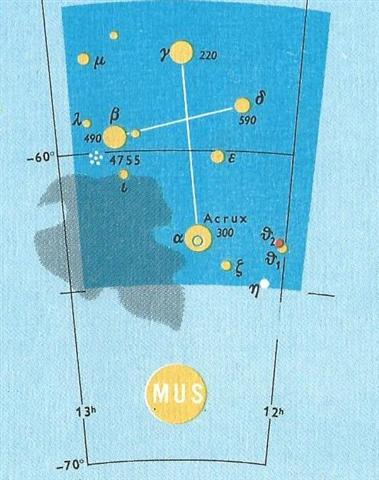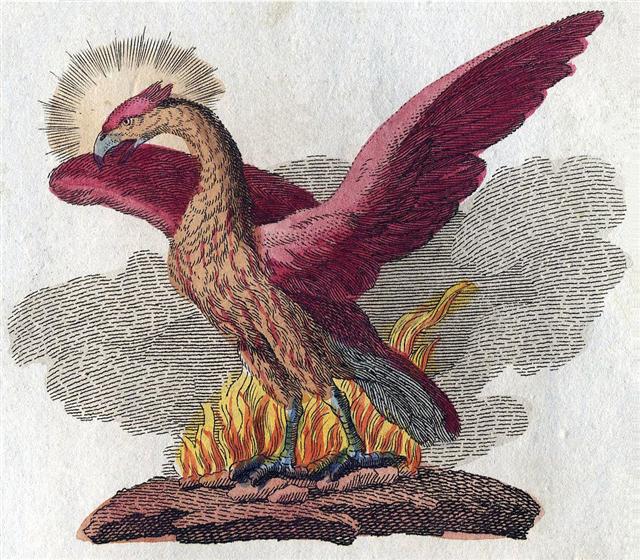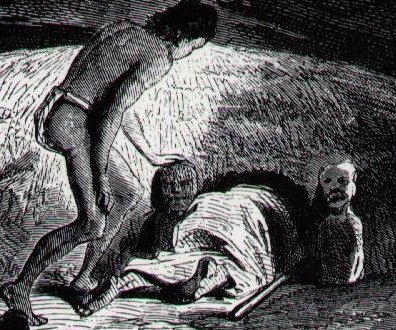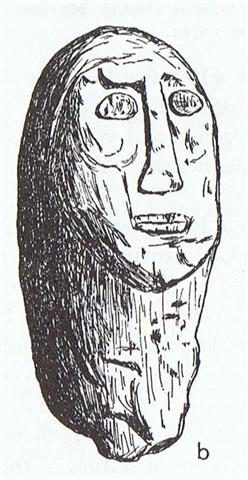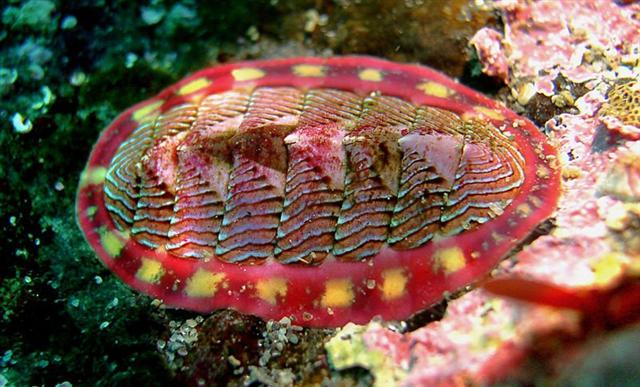Once again. In myth it was explained that the Raven (Corvus) came much too late and as a punishment he would never be allowed to drink water again. ... the bird, being sent with a cup for water, loitered at a fig-tree till the fruit became ripe, and then returned to the god with a water-snake in his claws and a lie in his mouth, alleging the snake to have been the cause of the delay. In punishment he was forever fixed in the sky with the Cup and the Snake; and, we may infer, doomed to everlasting thirst by the guardianship of the Hydra over the Cup and its contents. From all this came other poetical names for our Corvus - Avis Ficarius, the Fig Bird; and Emansor, one who stays beyond his time; and a belief, in early folk-lore, that this alone among birds did not carry water to its young ... If they once upon a time had suddenly changed their calendar convention for the year so that the true heliacal positions of the relevant stars now were being used instead of an earlier convention (viz. of using the positions of the stars when returning to visibility late in the early mornings), this could have caused the idea of the Corvus figure in the night sky arriving too late. 16 * 26000 / 365.25 = ca 1100 years of precessional change could then have been corrected. The stream of fresh water originating from the other side of the sky dome had run out of steam so to say - i.e. down into the Abyss and therefore out of reach for the thirsty Raven:
When the White Rabbit looked at his watch he had a similar situation - he was late:
... Oh dear! I shall be too late!' (when she thought it over afterwards it occurred to her that she ought to have wondered at this, but at the time it all seemed quite natural); but, when the Rabbit actually took a watch out of its waistcoat-pocket, and looked at it, and then hurried on, Alice started to her feet, for it flashed across her mind that she had never before seen a rabbit with either a waistcoat-pocket, or a watch to take out of it, and was just in time to see it pop down a large rabbit-hole under the hedge. In another moment down went Alice after it, never once considering how in the world she was to get out again ... *187 right ascension days after 0h (according to my suggested epoch for the rongorongo texts) - *16 (corresponding to a shift from returning to visibility to true heliacal position) = *171.
There was a 'Mouth' (an opening, vaha) through which the Sun entered in the mornings and another hole through which he left in the evenings.
To explain what happened at the equinoxes this diurnal pattern could be reused for the cycle of the Sun year: Vaha. Hollow; opening; space between the fingers (vaha rima); door cracks (vaha papare). Vahavaha, to fight, to wrangle, to argue with abusive words. Vanaga. 1. Space, before T; vaha takitua, perineum. PS Mgv.: vaha, a space, an open place. Mq.: vaha, separated, not joined. Ta.: vaha, an opening. Sa.: vasa, space, interval. To.: vaha, vahaa, id. Fu.: vasa, vāsaà, id. Niuē: vahā. 2. Muscle, tendon; vahavaha, id. Vahahora (vaha 1 - hora 2), spring. Vahatoga (vaha 1 - toga 1), autumn. 3. Ta.: vahavaha, to disdain, to dislike. Ha.: wahawaha, to hate, to dislike. Churchill.
Mea. 1. Tonsil, gill (of fish). 2. Red (probably because it is the colour of gills); light red, rose; also meamea. 3. To grow or to exist in abundance in a place or around a place: ku-mea-á te maîka, bananas grow in abundance (in this place); ku-mea-á te ka, there is plenty of fish (in a stretch of the coast or the sea); ku-mea-á te tai, the tide is low and the sea completely calm (good for fishing); mau mea, abundance. Vanaga. 1. Red; ata mea, the dawn. Meamea, red, ruddy, rubricund, scarlet, vermilion, yellow; ariga meamea, florid; kahu meamea purple; moni meamea, gold; hanuanua meamea, rainbow; pua ei meamea, to make yellow. Hakameamea, to redden, to make yellow. PS Ta.: mea, red. Sa.: memea, yellowish brown, sere. To.: memea, drab. Fu.: mea, blond, yellowish, red, chestnut. 2. A thing, an object, elements (mee); e mea, circumstance; mea ke, differently, excepted, save, but; ra mea, to belong; mea rakerake, assault; ko mea, such a one; a mea nei, this; a mea ka, during; a mea, then; no te mea, because, since, seeing that; na te mea, since; a mea era, that; ko mea tera, however, but. Hakamea, to prepare, to make ready. P Pau., Mgv., Mq., Ta.: mea, a thing. 3. In order that, for. Mgv.: mea, because, on account of, seeing that, since. Mq.: mea, for. 4. An individual; tagata mea, tagata mee, an individual. Mgv.: mea, an individual, such a one. Mq., Ta.: mea, such a one. 5. Necessary, urgent; e mea ka, must needs be, necessary; e mea, urgent. 6. Manners, customs. 7. Mgv.: ako-mea, a red fish. 8. Ta.: mea, to do. Mq.: mea, id. Sa.: mea, id. Mao.: mea, id. Churchill. Mago. Spotted dogfish, small shark. Vanaga. Mogo, shark. P Pau.: mago, id. Mgv. mago, id. Mq. mano, mako, mono, moko id. T. maó, id. In addition to this list the word is found as mago in Samoa, Maori, Niuē, and in Viti as mego. It is only in Rapanui and the Marquesas that we encounter the variant mogo. Churchill. On Easter Island, at the other side of the equator compared to England, the 'Rabbit' would emerge again quite quickly after having gone down up in the north. Because the hole for descending in the north was essentially the same as the hole for emerging in the south. The Entrance Pillar (Antares) was where the southern summer half of the year emerged, because at this time of the year Aldebaran (the Rear Pillar) could be observed close to the Full Moon. On one side of the hole was Antares and on the other was Aldebaran, one could think:
The pair Aldebaran and Antares (both great red stars) were similar to the ancient pair Castor (white) and Pollux (Orange). On Easter Island the idea was illustrated by a pair of figures (manu uru) at the exit out from the dark (uri) night interior ('death') of their hare paega homes - and this pair of figures ought to refer to Castor (*113) and to Pollux (*116) rather than to Aldebaran and Antares because they were standing so close together.
Uru. 1. To lavish food on those who have contributed to the funerary banquet (umu pâpaku) for a family member (said of the host, hoa pâpaku). 2. To remove the stones which have been heated in the umu, put meat, sweet potatoes, etc., on top of the embers, and cover it with those same stones while red-hot. 3. The wooden tongs used for handling the red-hot stones of the umu. 4. To enter into (kiroto ki or just ki), e.g. he-uru kiroto ki te hare, he-uru ki te hare. 5. To get dressed: kahu uru. Vanaga. Uruga. Prophetic vision. It is said that, not long before the first missionaries' coming a certain Rega Varevare a Te Niu saw their arrival in a vision and travelled all over the island to tell it: He-oho-mai ko Rega Varevare a Te Niu mai Poike, he mimiro i te po ka-variró te kaiga he-kî i taana uruga, he ragi: 'E-tomo te haûti i Tarakiu, e-tomo te poepoe hiku regorego, e-tomo te îka ariga koreva, e-tomo te poporo haha, e-kiu te Atua i te ragi'. I te otea o te rua raá he-tu'u-hakaou ki Poike; i te ahi mo-kirokiro he-mate. Rega Varevare, son of Te Niu, came from Poike, and toured the island proclaiming his vision: 'A wooden house will arrive at Tarakiu (near Vaihú), a barge will arrive, animals will arrive with the faces of eels (i.e. horses), golden thistles will come, and the Lord will be heard in heaven'. The next morning he arrived back in Poike, and in the evening when it was getting dark, he died. Vanaga. He ui a Ira.ko te motu etoru.he ki a Ira.he ro korua e kau a repa e ku ketu ana te urunga.a Hau maka o to tatou matua.i hakahi mai ai kia au.ko nga kope ririva tutuu vai a te taanga.te ingoa o te motu ena etoru i nape ai e te kuhane o Hau maka. Ira saw that there were three such islets. Ira said, 'Hey you, crew of young men, the vision of Hau Maka, our father, which he revealed to me, has come true. There are 'the handsome sons of Te Taanga, who are standing in the water', for this is the name that the dream soul of Hau Maka gave them. (E:17) Uru manu. Those who do not belong to the Miru tribe and who, for that reason, are held in lesser esteem. Úru-úru. To catch small fish to use as bait. Uru-uru-hoa. Intruder, freeloader (person who enters someone else's house and eats food reserved for another). Vanaga. 1. To enter, to penetrate, to thread, to come into port (huru); uru noa, to enter deep. Hakauru, to thread, to inclose, to admit, to drive in, to graft, to introduce, penetrate, to vaccinate, to recruit. Akauru, to calk. Hakahuru, to set a tenon into the mortise, to dowel. Hakauruuru, to interlace; hakauruuru mai te vae, to hurry to. 2. To clothe, to dress, to put on shoes, a crown. Hakauru, to put on shoes, to crown, to bend sails, a ring. 3. Festival, to feast. 4. To spread out the stones of an oven. Uruuru, to expand a green basket. 5. Manu uru, kite. Uruga (uru 1). Entrance. Churchill. Ta.: uru, the human skull. Mq.: uu, the head. Sa.: ulu, id. Moriori: ulu, id. Uru, make even. Kapingamarangi. The Babylonian idea of the night sky was that of an overturned boat:
... It is certainly true that the exterior form of the hare paenga, when the superstructure and thatch are intact, resembles an overturned boat, with the form established by the foundation. However, it is equally true (and perhaps equally important) that the configuration of the foundation is otherwise most like the Rapa Nui vulva design called komari. The komari is the quintessential female symbol which is everywhere prominent in Rapa Nui art, often carved in rock and wood, incised on human crania, and painted on the human body. In the hare paenga foundation form, the komari is cut in stone and embedded in the earth, the cosmologically female realm. Spanning above, over and virtually into this komari foundation is the ridgepole 'backbone' and curved rafter 'ribs' of what I surmise to be a symbolically male form. In short, we have a shelter which may be metaphorically understood as 'the sky father enclosing his progeny as he embraces the earth'. Those progeny entered and departed this male/female, earth/sky form through a low, dark tunnel which may be logically compared to the birth canal. This postulated symbolism does not, of course, negate the 'overturned boat' comparison, since Polynesian canoes were often likened to the bodies of great ancestors or to Tane as First Man. The canoe which transported the first exploratory voyage to Rapa Nui was said to have been called The Living Wood, a reference to Tane. Indeed, it is likely that the 'overturned boat' concept and its relationship to home, hearth and lineage, which is so graphically visible, was commonly understood (hence its retention in the oral literature), while the more esoteric godly connections, perhaps along the lines of those explored here, were known only by spiritual leaders ... ... Sky (rangi) and Earth (papa) lay in primal embrace, and in the cramped, dark space between them procreated and gave birth to the gods such as Tane, Rongo and Tu. Just as children fought sleep in the stifling darkness of a hare paenga, the gods grew restless between their parents and longed for light and air. The herculean achievement of forcing Sky to separate from Earth was variously performed by Tane in New Zealand and the Society Islands, by Tonofiti in the Marquesas and by Ru (Tu) in Cook Islands. After the sky was raised high above the earth, props or poles were erected between them and light entered, dispelling the darkness and bringing renewed life ...
... Raven began to search for the girls. For it is the way of things in the world that there are both males and females of every creature. Somewhere there must be girls. Raven searched and searched. Under logs and behind rocks, he looked. But he could not find the hiding place of the first girls. But as he searched, the tide was going out, and as it reached its lowest, the Raven spotted some giant Chitons clinging to the rocks. These giant shell fish had but one shell, fastened tightly to the rocks with huge soft lips around their edges. Raven pried one loose with his beak. And there inside was a girl. He pried off another, and another, and another in each was a girl. They were very similar to the creatures he had found in the clamshell, but more like the Chiton, softer and rounder, in contrast to the hard shell and strong muscles of the clam. And these were just as frightened of the Raven. He gathered them onto his back with difficulty, and brought them to the boys he had found in the clamshell ...
|
|||||||||||||||||||||||||||||||||||||||||||||||||||||||||||||||||||||||||||||||||||||||||||||||||||||||||||||||||||||||||||||||||||||||||||||||||||||||||||



